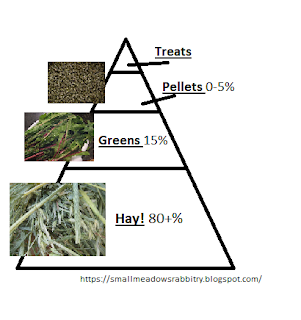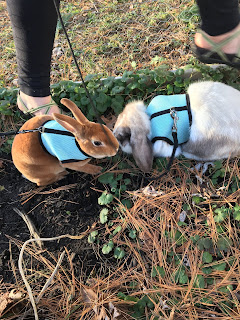Things You Should Know Before Getting A Rabbit
Hey guys!
Today I'm going to be sharing with you six things you need to know before getting a rabbit. When getting a rabbit, it's super important to fully understand the responsibilities that come with it.
Diet
It's important to give your rabbit a fiber rich diet. Here is a food pyramid I made:
Going from bottom to top, let's start with hay. Hay should make up about 80% of your rabbit's diet. It supports digestion, and prevents GI Stasis. For rabbits under 6 months, you should feed them alfalfa hay, and for rabbits 6 months and older, you should give them timothy hay or orchard grass.
Greens make up about 15% of their diet. Things such as spinach and wild plantains are great options. Our rabbits love some fresh greens veggies, especially on hot days.
Pellets make up 0-5% of the rabbit's diet. I say 0-5 because it is actually possible to go pellet free. there is a book on this subject called "Beyond the Pellet" by Boyd Craven Jr. and Rick Worden. Pellets are jsut there to make sure they are getting whatever else they need in their diet that hay and greens aren't giving them. You want to try to feed them timothy based pellets. If you can only find alfalfa, it's ok because rabbits only need from a quarter cup to a half cup per day. Try to find some without corn in them.
And finally treats. They should only have small amounts of treats. Things like bananas, apples and blueberries are our favorites! Try not to follow the stereotype that rabbits eat tons of carrots and lettuce, as carrots are very high in sugar, and most kinds of lettuce are very bad for rabbits.
Grooming is also very important. You should clip their nails about once a week, so they don't get sore hocks. You should also brush them once a day, to prevent hair balls and matts on their fur.
Greens make up about 15% of their diet. Things such as spinach and wild plantains are great options. Our rabbits love some fresh greens veggies, especially on hot days.
Pellets make up 0-5% of the rabbit's diet. I say 0-5 because it is actually possible to go pellet free. there is a book on this subject called "Beyond the Pellet" by Boyd Craven Jr. and Rick Worden. Pellets are jsut there to make sure they are getting whatever else they need in their diet that hay and greens aren't giving them. You want to try to feed them timothy based pellets. If you can only find alfalfa, it's ok because rabbits only need from a quarter cup to a half cup per day. Try to find some without corn in them.
And finally treats. They should only have small amounts of treats. Things like bananas, apples and blueberries are our favorites! Try not to follow the stereotype that rabbits eat tons of carrots and lettuce, as carrots are very high in sugar, and most kinds of lettuce are very bad for rabbits.
Maintenance
Maintenance can include things like daily sweep outs, and weekly/monthly scrubbing of the area you keep your rabbit. If your rabbit is indoors, you may need to clean more often, as it may not air out properly. We clean our hutches with a simple green and water solution, and we rinse them out with plenty of water afterwards.Grooming is also very important. You should clip their nails about once a week, so they don't get sore hocks. You should also brush them once a day, to prevent hair balls and matts on their fur.
Housing
Rabbits should have at least enough room to run around. we give each rabbit about 3 feet by 2 feet. if your rabbit is being kept indoors, make sure no other pets can get in, and the rabbit can't get out. You can also free roam it. You can let roam around one room, or even the whole house. Make sure you rabbit proof anything that can be accessed, from making sure it can't fall through any railings, to chewing your shoes. If you keep it outdoors, keep the rabbit at least 2-3 feet off the ground, or put wire on the grass so nothing can dig any holes. if you are worried about any predators getting in, install a safety lock. We use a wood block that turns on a screw.
Temperature and Weather
If your rabbit is outside, it's important to make sure they are prepared for the weather. In the summer, we give our rabbits frozen water bottles, and in the winter we fill their nesting boxes with straw or hay. It's important to remember to not transfer your rabbit outside and inside, as they are not acclimated to the conditions. It is possible if you only do it every once in a while, and you make sure the temperature difference isn't above 5 degrees. It isn't bringing your rabbit inside that is a problem, it's bringing them back out that messes with them.
Bonding
You should bond with your rabbit at least 30 minutes a day. Rabbits don't like being alone, so it's recommended that you have at least two, but if you can't do that just make sure to spend a little extra time with them. You can even teach your rabbit tricks. I've taught Calcifer to stand up for food, and I taught Sunny to come to me when I call. Sunny will also run to me when he sees me or hears my voice.
Spaying and Neutering
There are many things about rabbit fixing on the internet. Most of them tell you that it reduces the risk of cancer, when it really doesn't. People also think that it helps with hormonal behaviors and peeing everywhere. Rabbits will still do that. And if these things were true, the risks for rabbits in surgery is so high, you probably wouldn't want to.
I hope you guys learned something from this!




Comments
Post a Comment